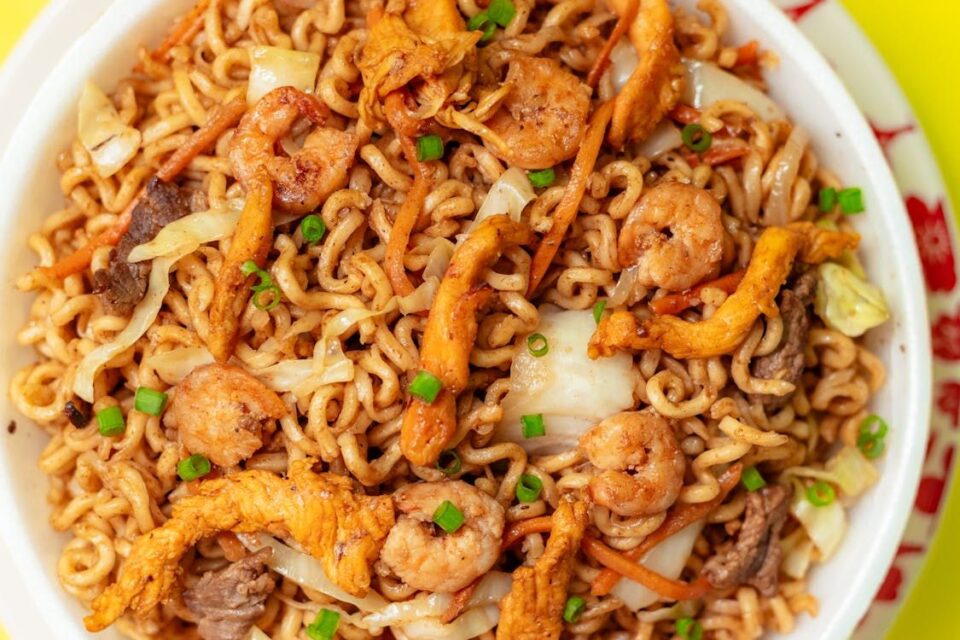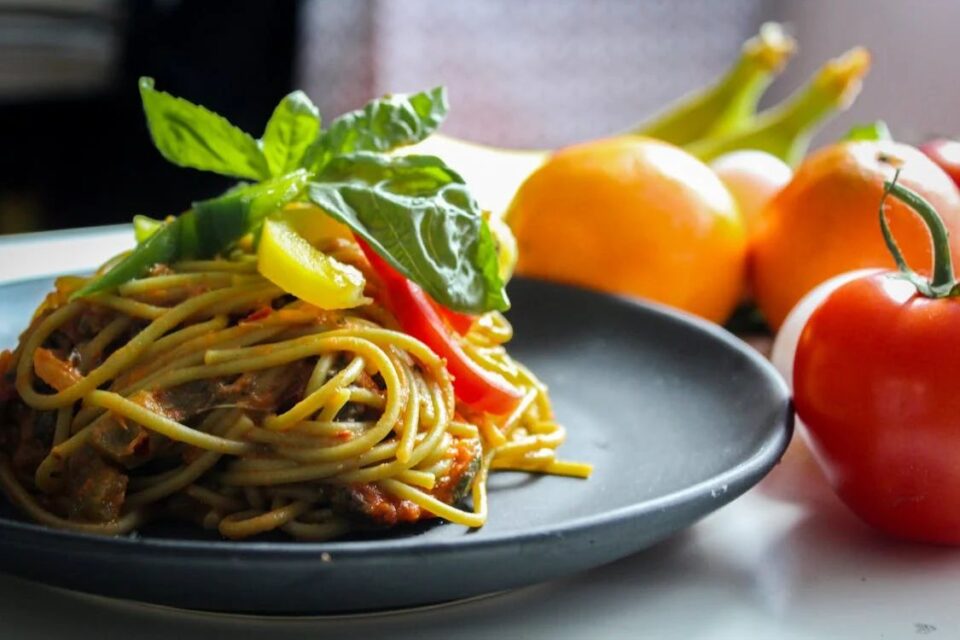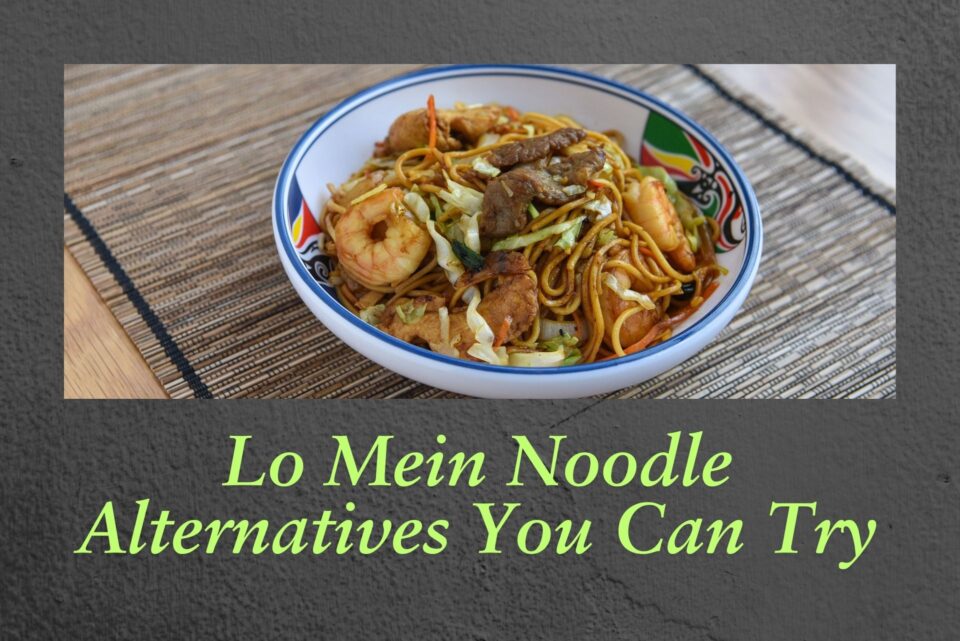Listed here are some remarkable Lo Mein Noodle alternatives that should not just save your recipe, but should you wish to, add another dimension of taste and flavor.
As a comfort food, these noodles are popular and beloved. However, there are times when you need a substitute for lo mein noodles. Well, for those times, we’ve got a list of ingredients and options that can work just right for you!
Generally, the top substitutes for lo mein noodles are chow mein, yakisoba noodles, linguine pasta, chop suey, ramen noodles, rice noodles, and spaghetti pasta.
For clarity, these substitutes can be further divided into different types. For example, the classic lo mein recipe could be replaced by the usual chow mein or chop suey (Chinese-American cuisine) recipe. You’d have a different dish, but one very similar to lo mein recipe, so these could be considered recipe substitutes.
The other approach is ingredient substitution, where you use another ingredient in place of lo mein noodles. Some examples of this are ramen noodles, spaghetti pasta, and others listed in this article.
Table of Contents
Top Alternative To Lo Mein Noodles
1. Chow Mein Noodles
As the recipe goes, chow mein noodles are an amazing alternative to a lo mein noodle dish.
Lo Mein and Chow Mein are so similar, they’re basically used interchangeably in many Western restaurants. So, it should be no surprise that chow mein noodles are excellent substitutes to lo mein noodles.
As things stand, chow mein and lo mein noodles are made from pretty much the same ingredients and are very similar. However, things start to change as you get to preparation.
To put things in oversimplified and somewhat crude terms, lo mein noodles are boiled, cooked, and drained before being added to the wok with other ingredients. In this method of preparation, they’re similar to several other popular noodle dishes like ramen, soba noodles, and udon.
On the other hand, chow mein noodles are first soaked in water, then stir fried with other ingredients, where they cook with the other ingredients.
A simple English translation from Cantonese should help with the difference: chow mein translates to “fried noodles” and lo mein translates to “mixed noodles”.
To sum up, chow mein noodles are excellent lo mein noodle substitutes because they are pretty much similar noodles, but with different methods of cooking.
2. Chop Suey
As a recipe, chop suey is a viable alternative to the conventional lo mein noodle recipe.
Chop Suey is often seen as an American dish, though its deep Chinese roots are undeniable. These noodles were made by early Chinese immigrants to the USA, who missed the flavors of home but couldn’t get the same ingredients in the USA.
It is usually made with rice and several other ingredients, though the famous one for Chinese-American cuisine is the dish made using noodles.
Interestingly, when used with noodles, the Chop Suey recipe uses stir-fried noodles like chow mein, accompanied by various ingredients like veggies, meat, and sauce. Depending on the recipe, chop suey may contain a starch-thickened gravy in a higher quantity than the sauce used for the usual lo mein recipe.
I should mention some caveats here, since the origins and change of recipes that travel nations and ethnicities can often be debatable. One claim is that chop suey originates from the Chinese tsap seui, which means various leftover/miscellaneous ingredients served with rice.
However, the modern definition can be different. Generally, in Chinese-American cuisine, a chop suey recipe involves chow mein noodles, gravy/sauce, and other ingredients like veggies or meat. A similar definition is used in other variations as well, including British-Chinese, Canadian-Chinese, and Indian-Chinese cuisine.
In most cases for modern multi-ethnic cuisine, a chop suey recipe will use stir-fried noodles in the chow mein style, but with a sauce in the lo mein style. The quantity of sauce/gravy in chop suey can be higher than in conventional lo mein recipes.
3. Yakisoba Noodles

Yakisoba noodles are a Japanese preparation, but they have inspiration from Chinese cuisine. In this case, they’re very close to lo mein noodles, though the preparation is somewhat similar to chow mein noodles. In fact, Yakisoba is sometimes called Japanese-style chow mein, given the similarities.
The base ingredients for yakisoba and chow mein (and thus, lo mein) are the same. However, yakisoba noodles are fried, which is what makes them similar to chow mein, rather than lo mein.
Although that little difference aside, yakisoba noodles can work as good lo mein noodle alternatives.
For those who have a preference for Japanese cuisine, this can work as a decent recipe substitution (making yakisoba rather than lo mein), or you can just do a simple ingredient substitution, making yakisoba in the same style as lo mein or chow mein noodles.
4. Linguine Pasta

Though this substitute for lo mein noodles jumps continents for cuisine, linguine pasta is a very good choice as a quick substitute. This big diameter pasta is almost the right thickness to work with lo mein noodles.
There will be some differences in overall taste and texture, but for most cases, it is the sauce and other ingredients that define the taste. As such, this substitution might pass off quite nicely. The texture is often not that easy to cover, though the difference is not huge.
Using whole-wheat pasta might make things easier, with a better approximation of the taste. Another option is to add a pinch of baking soda (bicarbonate) to the water as you boil the spaghetti. The alkaline touch this provides can make pasta taste very similar to noodles.
So, that makes for a viable, decent, and pretty easily available alternative to lo mein noodles!
5. Spaghetti Pasta

Much like linguine pasta, the long and thick strands of spaghetti can be a decent substitute for lo mein noodles. Those who like their noodles round and cylindrical, might prefer the use of spaghetti over linguine.
The substitution for these ingredients pretty much follows the same formula, including the use of baking soda during boiling spaghetti to give it a taste more similar to Asian noodles like lo mein.
On that note, not just spaghetti and linguine, any similar big diameter pasta made from wheat flour can work as a substitute to lo mein noodles.
The bigger difference and challenge when substituting dry spaghetti for lo mein noodles is that the noodles contain eggs. However, good handling of the recipe can make such differences minimal, allowing for pasta like spaghetti to be decent alternatives for lo mein noodles.
6. Ramen Noodles

The ever popular and famous ramen noodles can be good substitutes for lo mein noodles.
Technically, mein means noodles, so we’re essentially calling them lo noodles noodles, but language and nomenclature being what it is, often using the term lo mein noodles makes more sense.
After all, much of this article is a discussion of the noodles we use in the recipe called lo mein, and though recipe substitutions are also discussed in this article, ingredient substitution is relevant as well. So, we’ll just have to roll with these little vagaries of language and use the term lo mein noodles.
Anyways, getting back to the point, ramen noodles are very similar to lo mein noodles in terms of texture. The overall taste properties can be somewhat similar to lo mein noodles, in the sense that ramen noodles also derive most of their taste from the accompanying ingredients and sauce.
The chewy texture is also a plus for this substitution. So, while there will be some differences in the overall recipe, ramen noodles remain a very good substitute for lo mein noodles.
7. Rice Noodles
Rice noodles are the natural choice for those who would prefer their noodles to be gluten-free. Additionally, these noodles don’t use egg either, so they’re suitable for vegans as well. Thus, these noodles are a good substitute where specific diet preferences are concerned.
There are bound to be some variations in the recipe, since the light and delicate texture of rice noodles is notably different from lo mein noodles. However, rice noodles don’t present a flavor that overpowers the dish. Therefore, with the conventional lo mein preparation where the sauce and other ingredients provide the flavor, this alternative can produce a recipe with results very similar to the lo mein noodle recipe.
It’s worth noting that rice noodles need to be placed in hot water before preparing them, so they can soften. Once softened, they’re great at absorbing flavors from the recipe, adding consistency to the flavors of the recipe.
Picking Your Lo Mein Noodle Alternatives
As we see, there are several viable lo mein noodle alternatives and substitutes you can use. While there are several substitutes in Asian cuisine worth trying, you can also go ahead and try some pastas like linguine or spaghetti to work as alternatives.
Most of these options are readily available. Apart from availability and suitability for substitution, you can also consider rice noodles as a decent choice, especially for those looking for diet-suitable options like gluten-free or vegan-friendly substitutes. On that note, many dry pasta alternatives, like spaghetti can also be vegan-friendly.
The point is, be comfortable with the substitution you choose, and prepare a dish that’s suitable for your convenience, diet preferences, and tastes!

